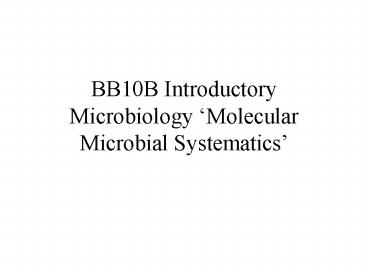BB10B Introductory Microbiology - PowerPoint PPT Presentation
1 / 21
Title:
BB10B Introductory Microbiology
Description:
Phylogenetics, tree of life, nomenclature. Lecture 2 Friday 20th Feb 9am. Metabolic diversity ... The tree of life. Eukaryote, prokaryote what is the difference? ... – PowerPoint PPT presentation
Number of Views:79
Avg rating:3.0/5.0
Title: BB10B Introductory Microbiology
1
BB10B Introductory Microbiology Molecular
Microbial Systematics
2
Lecture 1 Thursday 19th Feb 8am Phylogenetics,
tree of life, nomenclature Lecture 2 Friday 20th
Feb 9am Metabolic diversity Lecture 3 Tuesday
24th Feb 9am Domain bacteria Lecture 4 Thursday
26th Feb 8am Domain Archebacteria
3
(No Transcript)
4
(No Transcript)
5
(No Transcript)
6
Molecular Evolutionary Chronometers. 16S/18S rRNA
ia a functionally related molecules in all living
organisms. The genes which encode the 16SRNA
molecule can be isolated from any organism. It
performs the same function in all organisms.
Computers are used to compare the sequences. The
more different a sequence the greater the
evolutionary distance.
7
This study of evolutionary relationships between
organisms is called phylogeny and using mol boil
technology is called phylogenetics.
Stages in phylogenetic analysis
8
Taxononmy looks at how organisms appear. How
bacteria appear is not always useful at detecting
genetic relatedness. Looking at genes allows one
to get an accurate measure of how genetically
similar different organisms are. We now use
taxonomy to identify microorganisms.
Phylogenetics to classify microorganisms.
9
16S RNA is the best universal chronometer. Ribosme
s contain Protein and RNA. There are 3 RNA
molecules. 5S, 16S and 23S (Sedimentation). Large
bacterial RNAs 16S and 23S are 1500 and 2900
nucleotides long. They both have highly conserved
regions which allow the molecules to be aligned
and regions of seq. variability that allow
phylogenetic analysis. 5S has been used (120bp)
but it is of limited use. The 16S subunit is more
experimentally manageable. It has been used to
develop phylogenys between prokaryotes and the
18S Eukaryotic counterpart.
10
The tree of life
11
Eukaryote, prokaryote what is the difference? It
is thought that multicelluar eukaryotes evolved
from single celled eukaryotes. Single celled
eukaryotes are closer to the root than
multicellular This is supported by the tree.
Archaea are closer to eukaryotes than bacteria.
Proteobacteria is a taxonomically very diverse
group, that phylogenetics shows are all related.
12
(No Transcript)
13
(No Transcript)
14
Can also isolate DNA from a mixed culture of DNA
of DNA in the environment (eg soil, around a
thermal vent). Use PCR to amplify the 16S rRNA.
PCR can amplify from very low levels of DNA. 2nd
advantage of using PCR is that between 90 99 of
bacteria in a particular environment are not
culturable. So you can amplify rRNA from bacteria
that you cant culture and get information on
their classification.
15
The tree of Life
16
Community analysis
17
What is a bacterial species? Plants and animals a
species is defined as a population of individuals
that can interbreed (under normal conditions).
But for haploid prokaryotes this has no meaning.
They can of course rapidly evolve. To define
species it is normal to turn to molecular
biological methods.
18
A species is one that is defined as one whose 16S
RNA differs by more than 3 to all other
organisms should be considered a new species. A
new species will be defined by characterisation
of a number of strains or clones (define). Groups
of species are collected into genera (single
genus). Molecular criteria for a genus is 16S
identity of 93-95. Genera into Familes into
orders into classes into domain.
19
(No Transcript)
20
Nomenclature The naming of bacteria follows the
binomial system. Names are based on latin or
greek names and describe some property of the
bacteria. Genus name is first, followed by
species name. eg bacillus subtilis, bacillus
stearothermophilus.
21
When a new organism is discovered decisions are
made as to whether it is a new species or even in
a new genera. A description of the isolate is
made and a pure culture deposited with an
approved culture collection (eg ATCC, PCC). This
becomes the standard train for that species. They
are preserved live by freezing or freeze drying.
It is normal for a new species description to be
published in IJSB or at least a report deposited
there for it to be accepted. There is no
recognised list of organisms. Bergeys Manual of
Systematic Biology is taken as the best
compendium. The 3rd edition should have appeared
in 2000. There is a summary of the contents of
the 2nd in Brock 9th ed. It is not organised
phylogenetically. It is used by microbiologists
to aid in identification, classification of
organisms.































